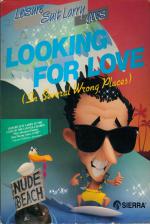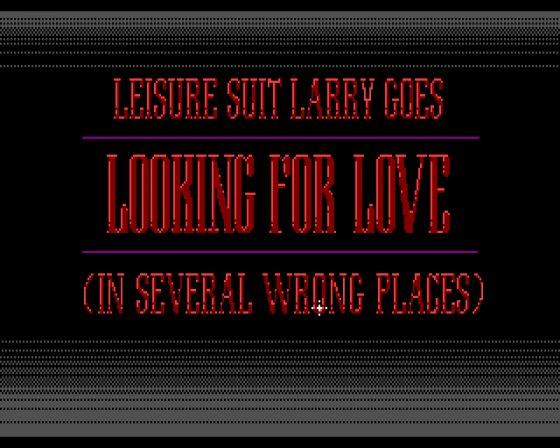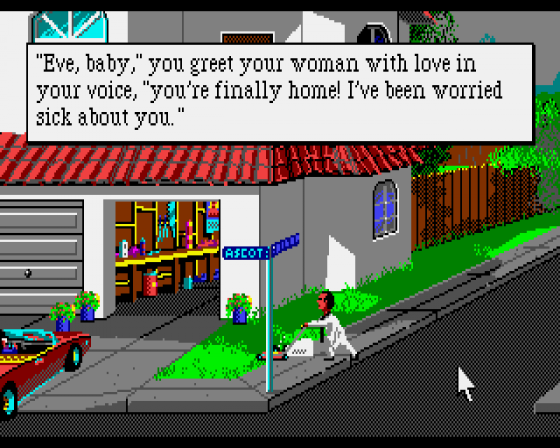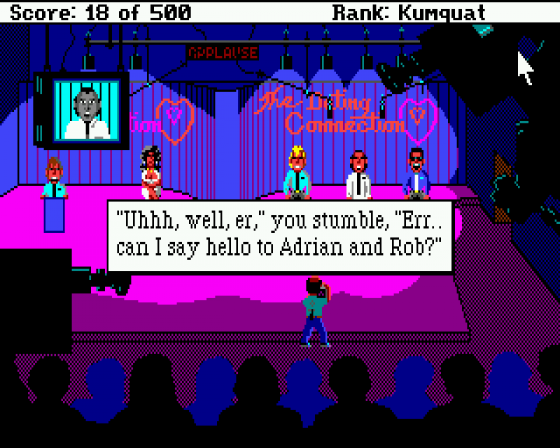
Commodore User
 1st April 1989
1st April 1989
Author: Keith Campbell
Publisher: Sierra
Machine: Amiga 500
Published in Commodore User #68
Leisure Suit Larry
Larry Laffer is rapidly becoming a cult character in the world of computer games players. He originally appeared in The Land Of The Lounge Lizards - an adult game in which, during a night on the town, he was on the lookout for women of easy virtue. It became something of a cult, particularly with brokers in the City.
Here is a James Bond comedy spoof, with a strong storyline. In an hilarious mix up when he accidentally finds himself a contestant in a wicked satirisation of TV's "Blind Date" (it's called "The Dating Connection" in the USA), Larry wins a month's cruise with Barbara Bimbo, and sets about getting together the things he will need for his holiday. Unfortunately for him, he accidentally strays into an ethnic musical instrument shop. By an amazing coincidence, when chatting up the attractive Hispanic girl behind the counter, his poor, Spanish matches exactly the phrases for a spy, who, by another amazing coincidence, turns out to be Larry's double.
Larry soon finds himself carrying a top secret microfiche secreted in an ancient Peruvian Onklunk, and becomes a target of the fiendish Dr. Nonookie, through his evil but seductive henchettes. As if that wasn't bad enough, it's Mrs. Bimbo who turns up on the cruise liner, not her daughter, and she has a penchant for chains and whips...

Larry decides to leave the cruise liner the hard way, and getting washed up on a holiday island, has to resort to disguising himself as a blonde in a bikini, to evade the local Russian spies. He gets away in an absolutely impossible cliff-hangar - literally! - that is agonisingly hilarious. Finally, of course, he has to catch up with Nonookie, and then marry the girl of his dreams.
This strong storyline is forced along by sequences of animation linking the 'free-will' puzzle sections, during which the player loses control of the action. The puzzles mainly concern finding and getting the requisite objects, and taking suitable actions which then trigger the narrative.
For example, Larry must have a ticket, passport and other objects essential later in the game, before he can board the cruise liner. If he takes too long to achieve this, the boat will leave without him, and he will have to start again. But it is not logical that he should be unable to board the ship without them, even if the long term results prevents him from completing the game. And this, perhaps, is where the Sierra format falls down. Allowing the narrative to continue, ultimately abortively, but with a strong hint or two in the text that all is not well, would then provide more realism and less frustration.
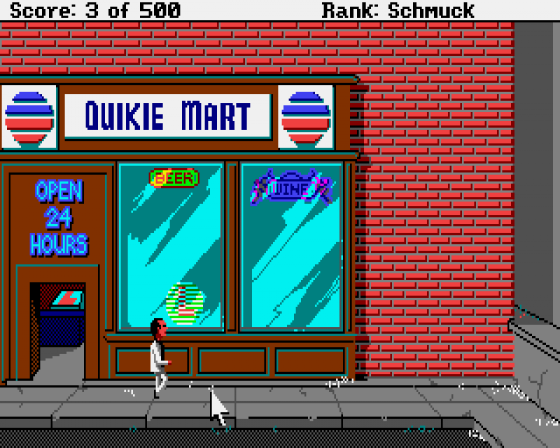
Having said that, this mixture of obligatory narrative, and obligatory player-driven events, is handled extremely well. Indeed, the narrative animation is often accompanied by great chunks of humorous text, which makes this game the comedy that it undoubtedly is.
Al Lowe, Larry's creator, says he deliberately introducted a strong storyline in Larry 2, to make it different from Larry 1, in which virtually every location is open from early on in the game. Larry 2 is far more linear. It's also less suggestive than its predecessor, despite its built in filth-o-meter. Turn the meter up, and you will get some direct language out of the screen, yet the actual situations themselves are not so spicy.
The graphics are doubled in resolution, compared with older Sierra games such as Space Quest II. This not only means that the pictures are more detailed, but the character that the player moves around the screen is better defined and thus more easy to control. Fine control is essential to get through the arcade sections of the game. You don't get something for nothing though, and the penalty is a longer response time whilst a new screen is being read in from disk. This is somewhat offset by picture caching, whereby the previous two or three locations visited are still held in memory, and redisplays very quickly.

There is also much more extensive animation. Not only does the main character have to negotiate some tricky arcade-like sequences, such as swinging across piranha-infested waters, jumping from vine to vine, and taking a precarious cliff-edge walk, there is natural movement in the background of many pictures that is incidental to the game or story itself. For example, the occasional plane crosses the sky, and trains can be seen streaking between hedgerows and buildings.
The text interface has been improved too. No longer does a cursor wait for input below the picture. Now, you just strike a character key, and an input window opens up superimposed on the main picture, containing any characters you have typed before it appears. The Save/Restore feature has also been made more user-friendly. On the old system, it always took me a while to figure out what directory and filename to assign a saved game - now things are much simplified.
If you have suitable sound equipment, do not fail to hook it up to your Amiga, for here is a major improvement. Full stereo sound is provided throughout the game, with various jingles and a few catchy tunes. These were composed by Al Lowe as well, himself the director of a High School Band, and school music co-ordinator for some sixteen years, before leaving teaching to go full time into computer games creation.
All in all, this is not only an adventure, but a complete entertainment package.

